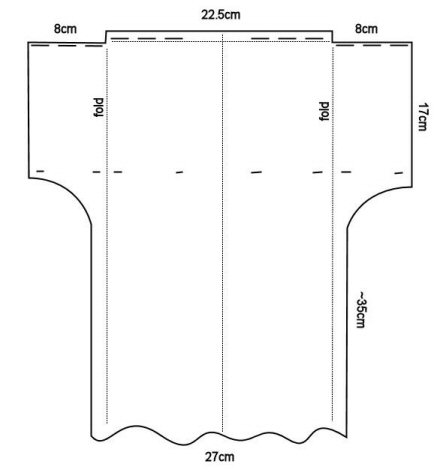
Fig 1: Basic slip-cover pattern.
Crispin Sexi (Jaysen Ollerenshaw), 2005
The term "girdle book" refers to a book that was bound in such a way that it had a "tail" that could be tucked into one's girdle or belt. This left the book hanging upside down; when the wearer wanted to read the book, they simply picked it up and opened it. When the book was being read from a table or lectern, the tail would have draped down off the edge.
For an example of girdlebooks see Spencer MS 39 on Edlyn's Scriptorium and also MS Rostgaard 6 on the Denmark Royal Library website.
Girdle books started to appear in the late 13thC, gathering popularity through the 14th and 15th, before going well over the top with jewel-encrusted presentation books and falling out of favour late in the 16thC.
There are only 26 medieval girdle books still in existence. The majority of the existing ones are religious texts, although some legal books and one medical book also still exist. It is hard to know for certain how common girdle books were, since many would have had their tails removed for reuse of the leather, especially once bookshelves became commonplace.
Girdle books are curious things, and I wanted one as soon as I found out about them. I didn't have any complete text that I wanted to bind, so instead I considered a blank girdle book for taking notes. Unfortunately my handwriting is messy; it seemed a sure thing that I would ruin an otherwise impressively constructed book. In the end I came up with the idea of a girdle book slip-cover for covering a modern notebook. Once I've used up the notebook I can get a new one. And I don't need to put blood, sweat and tears into learning real bookbinding, nor pay decent money for a well made girdle book that I'd then be too afraid to use.
This project is based on two 15thC books; Spencer MS 39 from Germany and Rostgaard MS 6 from Denmark. Both manuscripts are thong-bound with wooden boards and leather covers. They have Turk's head knots at the end of the tail, possibly added after the original binding. Those books also have decorative mounts appropriate to their era, riveted or nailed to the outside corners, and are fastened with clasps. The girdle binding is held to the book by the decorative mounts and possibly also glue, with no evidence of stitching. The edges of the leather binding of the Rostgaard book and also part of the Spencer book are left sticking out as a "chemise edging" rather than folded neatly under the covers and secured in place. Interestingly, the Spencer manuscript's girdle binding is over the top of a normal leather binding, and the Rostgaard's girdle binding was added about 1540, presumably also over the original binding. Possibly these books were turned into girdle books once they had proven themselves to be indispensable. The book dimensions of the originals are:
Spencer: 10.4 cm. x 7.5 cm, with ~21 cm long binding.
Rostgaard: 13 x 9.6 cm, with 30 cm long binding.
The pattern in fig 2 is made to fit an A6 size hardcover notebook with dimensions 15cm x 10.5cm x 1cm. I used hardcover to approximate the wooden boards of the original books. If you use a spiral bound or different sized notebook, you will need to adjust the measurements accordingly.

Fig 1: Basic slip-cover pattern.
For the cover use fairly soft leather, 1mm or thinner. You'll need a piece about 40cm by 60cm (roughly 4 times the book's height and breadth). Mark out the pattern on the underside of the leather using a pencil. Check the pattern by folding it around your notebook - the side flaps should fold in about three quarters of the way. When you are happy, cut it out using a leather knife or some sharp scissors.
Fold the side flaps in and hold them in place using clothes pegs. Use a leather needle and waxed leatherworking thread to sew the top flap down to the top edge of the side flaps. The stitching should be 1mm from the edge of the side flap and 4mm from the edge of the top flap. This will leave a "chemise edging" like that on the original books.

Fig 2: Chemise edging
Insert the book and sew some stitches near the bottom edge (The dashes in the middle of Fig 2) to give a few points to hold the book in place. I used only a few stitches so that they were not obvious. The original books relied on the bosses and possibly glue to hold them in place and did not have a seam or any other fastening at the start of the tail.
Scrunch together the bottom of the tail in concertina folds and tie a knot in it.
Use a wrap-around strap 6 times the width of the book to fasten the book closed. Stitch it to the front centre edge of the front cover and wind it a few times about the book and tuck in the end to secure it.

Fig 3: The final result
Edlyn's Scriptorium,
Spencer MS. 39 - A 15th Century German Girdle Book
http://home.earthlink.net/~ckbonder/id1.html
Accessed 7/1/2005
The Law of Jutland. Denmark c. 1490.
MS Rostgaard 6
http://www.kb.dk/elib/mss/treasures/bogbind/rostgaard_6.htm
Accessed 7/1/2005
Etherington & Roberts. Dictionary--clasps,
Bookbinding and the Conservation of Books
A Dictionary of Descriptive Terminology
http://palimpsest.stanford.edu/don/dt/dt0709.html
Accessed 7/1/2005
Egan, Geoff, The Medieval Household, Daily Living c.1150-c.1450, The Stationery Office, London, 1998.
Egan, Geoff and Frances Pritchard, Dress Accessories, c.1150-c.1450, The Boydell Press, Woodbridge, 2002.
Copyright Jaysen Ollerenshaw 2005. Free use for non-profit.
Joan & Crispin's Homepage: https://wotnot.squanderlings.com/